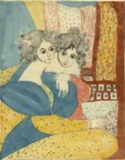- Mary Ann Willson
-
Mary Ann Willson (active 1815 to 1825) was an American folk artist, known for her watercolors. She was unknown until 1943, when a portfolio of her work was discovered by a gallery in New York. Today she is regarded alongside Eunice Pinney as one of the earliest American painters to work in the medium of watercolor.
The artist's name is known from an anonymous letter, written in 1850 and signed by "an admirer of art", which was found with the drawings. According to this, Willson moved to Greenville, New York, around 1810, being accompanied by a Miss Brundage, or Brundidge. The two built a log cabin, and Brundage farmed the land. Willson painted pictures for nearby farmers; supposedly, her work was sold from Canada to Mobile, Alabama.
Stylistically, Willson's drawings are the work of an untrained hand; her subjects are taken from popular prints of the day, and are painted brightly in paints made from berry juice, vegetable dye, or brick dust. At Brundage's death, Willson is said to have been inconsolable, and disappeared not long after. Her last known work was completed in 1825; what became of her afterwards is unknown.
Willson's story served as the basis for Alma Routsong's 1969 novel Patience and Sarah.
References
Categories:- American painters
- Outsider artists
- American women artists
- Folk artists
- LGBT artists from the United States
- Women painters
- Artists from New York
- American watercolorists
Wikimedia Foundation. 2010.

